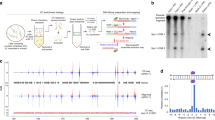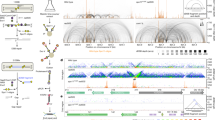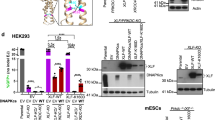Abstract
The most dangerous insults to the genome’s integrity are those that break both strands of the DNA. Double-strand breaks can be repaired by homologous recombination; in this conserved mechanism, a global genomic homology search finds sequences similar to those near the break, and uses them as a template for DNA synthesis and ligation1. Chromosomes occupy restricted territories within the nucleus2,3. We show that yeast genomic regions whose nuclear territories overlap recombine more efficiently than sequences located in spatially distant territories. Tethering of telomeres and centromeres4,5 reduces the efficiency of recombination between distant genomic loci, lowering the chances of non-allelic recombination. Our results challenge present models that posit an active scanning of the whole nuclear volume by the broken chromosomal end; they demonstrate that the search for homology is a limiting step in homologous recombination, and emphasize the importance of nuclear organization in genome maintenance.
This is a preview of subscription content, access via your institution
Access options
Subscribe to this journal
Receive 12 print issues and online access
$209.00 per year
only $17.42 per issue
Buy this article
- Purchase on Springer Link
- Instant access to full article PDF
Prices may be subject to local taxes which are calculated during checkout




Similar content being viewed by others
References
Barzel, A. & Kupiec, M. Finding a match: how do homologous sequences get together for recombination? Nat. Rev. Genet. 9, 27–37 (2008).
Cremer, T. & Cremer, M. Chromosome territories. Cold Spring Harb. Perspect. Biol. 2, a003889 (2010).
Berger, A. B. et al. High-resolution statistical mapping reveals gene territories in live yeast. Nat. Methods 5, 1031–1037 (2008).
Taddei, A., Schober, H. & Gasser, S. M. The budding yeast nucleus. Cold Spring Harb. Perspect. Biol. 2, a000612 (2010).
Zimmer, C. & Fabre, E. Principles of chromosomal organization: lessons from yeast. J. Cell Biol. 192, 723–733 (2011).
Forget, A. L. & Kowalczykowski, S. C. Single-molecule imaging of DNA pairing by RecA reveals a three-dimensional homology search. Nature 482, 423–427 (2012).
Burgess, S. M. & Kleckner, N. Collisions between yeast chromosomal loci in vivo are governed by three layers of organization. Gen. Dev. 13, 1871–1883 (1999).
Goldman, A. S. & Lichten, M. The efficiency of meiotic recombination between dispersed sequences in Saccharomyces cerevisiae depends upon their chromosomal location. Genetics 144, 43–55 (1996).
Lieberman-Aiden, E. et al. Comprehensive mapping of long-range interactions reveals folding principles of the human genome. Science 326, 289–293 (2009).
Therizols, P., Duong, T., Dujon, B., Zimmer, C. & Fabre, E. Chromosome arm length and nuclear constraints determine the dynamic relationship of yeast subtelomeres. Proc. Natl Acad. Sci. USA 107, 2025–2030 (2010).
Schober, H. et al. Controlled exchange of chromosomal arms reveals principles driving telomere interactions in yeast. Genome Res. 18, 261–271 (2008).
Agmon, N., Pur, S., Liefshitz, B. & Kupiec, M. Analysis of repair mechanism choice during homologous recombination. Nucleic Acids Res. 37, 5081–5092 (2009).
Aylon, Y., Liefshitz, B., Bitan-Banin, G. & Kupiec, M. Molecular dissection of mitotic recombination in the yeast Saccharomyces cerevisiae. Mol. Cell Biol. 23, 1403–1417 (2003).
Inbar, O. & Kupiec, M. Recombination between divergent sequences leads to cell death in a mismatch-repair-independent manner. Curr. Genet. 38, 23–32 (2000).
Wong, H. et al. A predictive computational model of the dynamic 3D interphase yeast nucleus. Curr. Biol. 22, 1881–1890 (2012).
Soutoglou, E. et al. Positional stability of single double-strand breaks in mammalian cells. Nat. Cell Biol. 9, 675–682 (2007).
Kaye, J. A. et al. DNA breaks promote genomic instability by impeding proper chromosome segregation. Curr. Biol. 14, 2096–2106 (2004).
Kleckner, N. et al. A mechanical basis for chromosome function. Proc. Natl Acad. Sci. USA 101, 12592–12597 (2004).
Guacci, V. & Kaback, D. B. Distributive disjunction of authentic chromosomes in Saccharomyces cerevisiae. Genetics 127, 475–488 (1991).
Bermejo, R. et al. The replication checkpoint protects fork stability by releasing transcribed genes from nuclear pores. Cell 146, 233–246 (2011).
Hiraga, S., Botsios, S. & Donaldson, A. D. Histone H3 lysine 56 acetylation by Rtt109 is crucial for chromosome positioning. J. Cell Biol. 183, 641–651 (2008).
Bupp, J. M., Martin, A. E., Stensrud, E. S. & Jaspersen, S. L. Telomere anchoring at the nuclear periphery requires the budding yeast Sad1-UNC-84 domain protein Mps3. J. Cell Biol. 179, 845–854 (2007).
Neumann, F. R. et al. Targeted INO80 enhances subnuclear chromatin movement and ectopic homologous recombination. Gen. Dev. 26, 369–383 (2012).
Wilson, J. H., Leung, W. Y., Bosco, G., Dieu, D. & Haber, J. E. The frequency of gene targeting in yeast depends on the number of target copies. Proc. Natl Acad. Sci. USA 91, 177–181 (1994).
Melamed, C. & Kupiec, M. Effect of donor copy number on the rate of gene conversion in the yeast Saccharomyces cerevisiae. Mol. Gen. Genet. 235, 97–103 (1992).
Mine-Hattab, J. & Rothstein, R. Increased chromosome mobility facilitates homology search during recombination. Nat. Cell Biol. 14, 510–517 (2012).
Dion, V., Kalck, V., Horigome, C., Towbin, B. D. & Gasser, S. M. Increased mobility of double-strand breaks requires Mec1, Rad9 and the homologous recombination machinery. Nat. Cell Biol. 14, 502–509 (2012).
Dimitrova, N., Chen, Y. C., Spector, D. L. & de Lange, T. 53BP1 promotes non-homologous end joining of telomeres by increasing chromatin mobility. Nature 456, 524–528 (2008).
Goodarzi, A. A., Kurka, T. & Jeggo, P. A. KAP-1 phosphorylation regulates CHD3 nucleosome remodeling during the DNA double-strand break response. Nat. Struct. Mol. Biol. 18, 831–839 (2011).
Koszul, R., Kim, K. P., Prentiss, M., Kleckner, N. & Kameoka, S. Meiotic chromosomes move by linkage to dynamic actin cables with transduction of force through the nuclear envelope. Cell 133, 1188–1201 (2008).
Dundr, M. et al. Actin-dependent intranuclear repositioning of an active gene locus in vivo. J. Cell Biol. 179, 1095–1103 (2007).
Kalhor, R., Tjong, H., Jayathilaka, N., Alber, F. & Chen, L. Genome architectures revealed by tethered chromosome conformation capture and population-based modeling. Nat. Biotechnol. 30, 90–98 (2012).
Guelen, L. et al. Domain organization of human chromosomes revealed by mapping of nuclear lamina interactions. Nature 453, 948–951 (2008).
De, S. & Babu, M. M. Genomic neighbourhood and the regulation of gene expression. Curr. Opin. Cell Biol. 22, 326–333 (2010).
Nussenzweig, A. & Nussenzweig, M. C. Origin of chromosomal translocations in lymphoid cancer. Cell 141, 27–38 (2010).
Fudenberg, G., Getz, G., Meyerson, M. & Mirny, L. A. High order chromatin architecture shapes the landscape of chromosomal alterations in cancer. Nat. Biotechnol. 29, 1109–1113 (2011).
Vollrath, D., Davis, R. W., Connelly, C. & Hieter, P. Physical mapping of largeDNA by chromosome fragmentation. Proc. Natl Acad. Sci. USA 85, 6027–6031 (1988).
Gauss, R., Trautwein, M., Sommer, T. & Spang, A. New modules for the repeated internal and N-terminal epitope tagging of genes in Saccharomyces cerevisiae. Yeast 22, 1–12 (2005).
Knop, M. et al. Epitope tagging of yeast genes using a PCR-based strategy: more tags and improved practical routines. Yeast 15, 963–972 (1999).
Acknowledgements
This work was supported by grants from the Israel Science Foundation and the Israeli Ministry of Science and Technology to M.K. N.A. was supported by an Eshkol fellowship from the Israeli Ministry of Science and Technology. C.Z. thanks Institut Pasteur, Agence Nationale de la Recherche (grant ANR-09-PIRI-0024) and Fondation pour la Recherche Médicale (Équipe FRM) for support. E.F. thanks Institut Pasteur and Agence Nationale de la Recherche (grant ANR-09-PIRI-0024).
Author information
Authors and Affiliations
Contributions
E.F., C.Z., N.A. and M.K. conceived the project and wrote the paper. N.A., B.L. and M.K. created yeast strains and carried out the recombination experiments. E.F. mapped the cassette locations within the nucleus and C.Z. carried out the statistical analyses.
Corresponding authors
Ethics declarations
Competing interests
The authors declare no competing financial interests.
Supplementary information
Supplementary Information
Supplementary Information (PDF 772 kb)
Supplementary Table 1
Supplementary Information (XLSX 9 kb)
Supplementary Table 2
Supplementary Information (XLSX 14 kb)
Rights and permissions
About this article
Cite this article
Agmon, N., Liefshitz, B., Zimmer, C. et al. Effect of nuclear architecture on the efficiency of double-strand break repair. Nat Cell Biol 15, 694–699 (2013). https://doi.org/10.1038/ncb2745
Received:
Accepted:
Published:
Issue Date:
DOI: https://doi.org/10.1038/ncb2745
This article is cited by
-
In vivo tracking of functionally tagged Rad51 unveils a robust strategy of homology search
Nature Structural & Molecular Biology (2023)
-
Chemically Induced Chromosomal Interaction (CICI) method to study chromosome dynamics and its biological roles
Nature Communications (2022)
-
Cohesin puts a break on distal homology hunt
Nature Cell Biology (2021)
-
Lessons from the Nakaseomyces: mating-type switching, DSB repair and evolution of Ho
Current Genetics (2021)
-
Double-strand breaks in motion: implications for chromosomal rearrangement
Current Genetics (2020)



